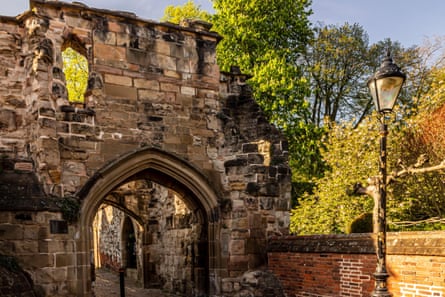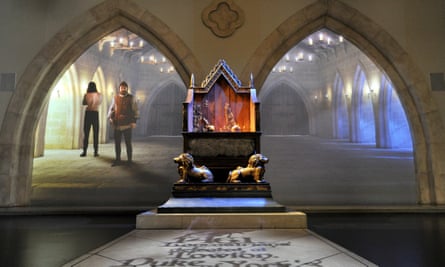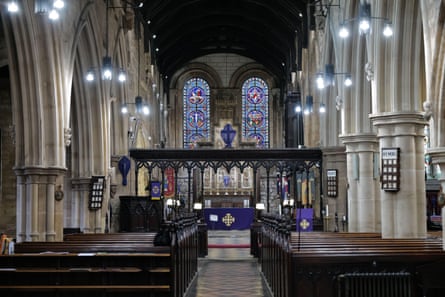Standing on a frozen ridge at Bosworth Field, my feeling is that there are certainly less attractive places to draw one’s last breath. On this frigid December afternoon, I’m looking out at a mist-shrouded hinterland of crisscrossing fields as a milky orange sun sinks behind a distant smudge of cloud. Somewhere out there on that bleak horizon in August 1485, King Richard III died a violent death, made all the more visceral by the gaudy array of spiked weapons hanging on a wall inside the nearby Bosworth Battlefield Heritage Centre, celebrating its 50th anniversary in 2024.

It’s one of several upcoming anniversaries related to the last English king to die in battle, and the next morning I’m tackling the new King Richard III Walking Trail around the epicentre of Richard lore, Leicester. After the headline-grabbing discovery of Richard’s skeleton beneath a council car park in Greyfriars in August 2012, Leicester now seems entirely inseparable from the last Plantagenet king, as if a long-lost lover had returned in a blaze of glory after 500 years.
“It was like looking for a needle in a haystack; everyone was surprised when they found him,” says Phil Hackett, manager at the King Richard III Visitor Centre, also celebrating its 10th anniversary in 2024. “The press just went mad and it was an international story.”
Hackett is passionate about bringing Richard’s ever-evolving story to as many visitors as possible in a city that saw tourism numbers jump from 9 million a year to 12.3 million after the events of 2012.
The new trail is a zigzagging loop around the city centre that takes about an hour to walk, stopping at various sites relating to Richard along the way.
We begin at the site of the former Greyfriars Friary, where a charcoal-grey plaque on an elegant Edwardian bank informs us that this is where the king’s mangled body was interred after the Battle of Bosworth Field.

The narrow, gently arcing New Street looks north towards Peacock Lane and perfectly frames the steep spire of Leicester Cathedral between some handsome brick Georgian townhouses. The street also allows a glimpse into the notorious car park that once commanded the attention of the world’s media, and through the drizzle I’m reminded again how amusing it is that the lost king was unearthed somewhere so crushingly mundane.
The rain picks up as Hackett guides me south towards the Magazine, an imposing sandstone gateway built around 1410 under which Richard’s body would probably have passed on horseback after his defeat. It now sits incongruously on the busy Vaughan Way and looks even stranger next to the glassy turquoise frame of De Montford University’s Hugh Aston Building. I’d gawp at it longer, but the rain twinned with the groan of traffic on hissing asphalt forces us to move on.

The Newarke is a pretty hodgepodge of Georgian and Victorian architecture, flanked to the north by Trinity Hospital and the university’s handsome Hawthorne Building to the south. Hidden away beside a lecture hall, we come across the only surviving arches from the destroyed Church of the Annunciation of the Blessed Mary, where it’s thought that the victorious Henry Tudor put Richard’s body on display for three days, as indisputable proof that the king was indeed dead.
“At the moment we tell the story of Richard III, but I do think we need to start telling more of the story of Henry Tudor,” says Hackett as we exit. “He’s the beginning of the Tudor period. So Leicester was the site of two kings – where one king ended his life, and another started his.”

We pass beneath the Turret Gateway on Castle View, another formidable 15th-century stone gateway and, as the incessant rain crackles against my umbrella, we dive inside the recently reopened Castle pub for a beer away from the deluge.
after newsletter promotion
An antique shop in the 1990s, the pub is a rustic 18th-century sanctuary and beneath black timber beams. Hackett heads rather surprisingly off-piste to tell me about his two-man hip-hop group Relevant Elephant – “imagine American west coast rap music, performed by middle-aged, middle-class white blokes in Leicester.”

Back on the trail, we cross glimmering cobbled stones on the short walk to the 12th-century St Mary de Castro church where we’re hit by a waft of rich incense on entering. Not only did Richard probably pray at the church’s altar the night before the battle, it’s also rumoured that Geoffrey Chaucer married his second wife here in the 1360s.
The walk then snakes by the languid willows and skeletal branches of Castle Gardens, where the River Soar becomes visible – Richard’s long-assumed final resting spot before 2012’s revelations.
Outside the park, the Victorian Bow Bridge’s ornate wrought-iron railings depict the Tudor Rose. This is where Richard probably crossed on the way to Bosworth, though I’m more intrigued by the canal towpath below, where a wall is splashed in a colourful graffiti depiction of his famous (or infamous, if you’re a Ricardian) portrait. I’m hardly a sage of street art, but I imagine there can’t be too much medieval-themed graffiti out there, and I assume this quirky canvas will form part of Leicester’s Bring the Paint festival in May.

Our final stop is Leicester Cathedral, recently reopened after a two-year £15m renovation project. I wander over to Richard’s final burial spot – a striking angular tomb made from Swaledale fossil stone quarried in North Yorkshire. It’s solemn, simple and oddly moving.
While the trail doesn’t break any new ground on Richard’s life (save that for the visitor centre), it does feel as if I’m walking in his footsteps at times. And that makes one of history’s more mysterious monarchs all the more real for it.
 Top Naija News: Nigerian News, Breaking News Nigeria and World News Top Naija News is a daily news publication in Nigeria, delivering the latest breaking news in Nigeria and around the world.
Top Naija News: Nigerian News, Breaking News Nigeria and World News Top Naija News is a daily news publication in Nigeria, delivering the latest breaking news in Nigeria and around the world.



